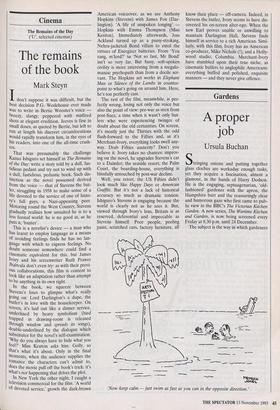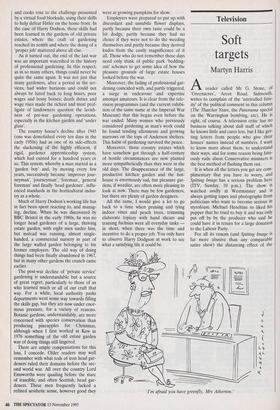Gardens
A proper job
Ursula Buchan
Stringing onions and putting together glass cloches are workaday enough tasks, yet they acquire a fascination, almost a glamour, in the hands of Harry Dodson. He is the engaging, septuagenarian, 'old- fashioned' gardener with the apron, the Hampshire burr and the reassuringly clear and humorous gaze who first came to pub- lic view in the BBC's The Victorian Kitchen Garden. A new series, The Wartime Kitchen and Garden, is now being screened every Friday at 8.30 p.m. until 24 December.
The subject is the way in which gardeners 'Now keep calm — just swim as fast as you can in the opposite direction.' and cooks rose to the challenge presented by a virtual food blockade, using their skills to help defeat Hitler on the home front. In the case of Harry Dodson, these skills had been learned in the gardens of old private estates, where the craft of gardening reached its zenith and where the doing of a 'proper job' mattered above all else.
As it turned out, the end of the last war was an important watershed in the history of professional gardening. In this respect, as in so many others, things could never be quite the same again. It was not just that many gardeners, after a period in the ser- vices, had wider horizons and could not always be lured back to long hours, poor wages and bossy bosses; death duties and wage rises made the richest and most prof- ligate of landowners question the lavish- ness of pre-war gardening operations, especially in the kitchen garden and 'under glass'.
The country house's decline after 1945 (one was demolished every ten days in the early 1950s) had as one of its side-effects the slackening of the highly efficient, if rigid, gardener apprenticeship system, which had existed for a hundred years or so. This system, whereby a man started as a 'garden boy' and, by moving every few years, successively became `improver jour- neyman', 'journeyman', 'foreman', 'general foreman' and finally 'head gardener', influ- enced standards in the horticultural indus- try as a whole.
Much of Harry Dodson's working life has in fact been spent reacting to, and manag- ing, decline. When he was discovered by BBC Bristol in the early 1980s, he was no longer head gardener of a large, thriving estate garden, with eight men under him, but instead was running, almost single- handed, a commercial nursery in part of the large walled garden belonging to his former employers. The old way of doing things had been finally abandoned in 1967, but in many other gardens the crunch came earlier.
The post-war decline of 'private service' gardening is understandable but a source of great regret, particularly to those of us who learned much or all of our craft that way. For a while, local authority parks departments went some way towards filling the skills gap, but they are now under enor- mous pressure, for a variety of reasons. Botanic gardens, understandably, are more concerned with species conservation than producing pineapples for Christmas, although when I first worked at Kew in 1976 something of the old estate garden way of doing things still lingered.
There are ample compensations for this loss, I concede. Older readers may well remember with what rods of iron head gar- deners ruled their domains before the sec- ond world war. All over the country Lord Emsworths were quailing before the stare of irascible, and often Scottish, head gar- deners. These men frequently lacked a refined aesthetic sense, however good they were at growing pumpkins for show.
Employers were prepared to put up with discordant and unsubtle flower displays, partly because their own taste could be a bit dodgy, partly because they had no choice if they were not to do the weeding themselves and partly because they derived kudos from the costly magnificence of it all. Those who do not remember those days need only think of public park 'bedding- out' schemes to get some idea of how the pleasure grounds of large estate houses looked before the war.
Moreover, the fading of professional gar- dening coincided with, and partly triggered, a surge in endeavour and expertise amongst amateurs. It is clear from the tele- vision programmes (and the current exhibi- tion of the same name at the Imperial War Museum) that this began even before the war ended. Many women who previously considered gardening as man's work could be found tending allotments and growing marrows on the tops of Anderson shelters. This habit of gardening survived the peace.
Moreover, those country estates which have somehow got through a half-century of hostile circumstances are now planted more sympathetically than they were in the old days. The disappearance of the large, productive kitchen garden and the hot- house is enormously sad, but pleasure gar- dens, if weedier, are often more pleasing to look at now. There may be few gardeners, but there are plenty of garden designers.
All the same, I would give a lot to go back to a time when pruning and tying indoor vines and peach trees, trimming elaborate topiary with hand shears and training fuchsias were all everyday tasks — in short, when there was the time and incentive to do a proper job. You only have to observe Harry Dodgson at work to see what a satisfying life it could be.



























































 Previous page
Previous page